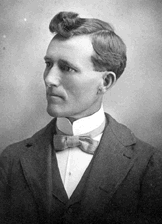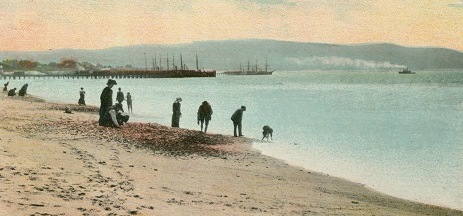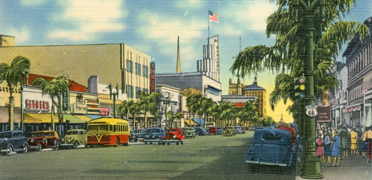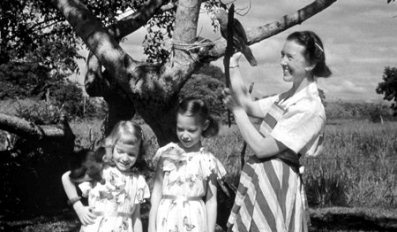
|
Edward J. Van Horn: |
|
By the Late Ruth (Van Horn) Snyder |
 |
| Edward J. Van Horn Walker Studio in Bowling Green, OH |
Editor's note - This is a brief biography, mostly of Edward Jacob Van Horn, written by his daughter, Ruth Van Horn Snyder, probably in the early 1990s. It seems to end a little abruptly, but it's not known if any text is missing. Notes in [brackets] were added by Ruth's daughter Carol McGann. The portrait of Edward was made in Ohio, prior to his move to Southern California.
Perhaps it would help to fill out the family tree if I were to write what I remember about those I have met or what I have been told.
My parents met while teaching school in Ohio. As my mother always taught first grade I assume my dad may have taught lower grades at one time as I believe they taught in the same school at one time.
At the time my dad came to California (1902), I believe he was teaching at Ada, at the same University from which he had graduated. One piece of memorabilia was a graduation program. Each graduate gave a speech—not just the valedictorian. I was never able to read what my father wrote, which I assume was his speech. His penmanship was illegible and when the ink faded it became more so. As I understand it, the services went on for several days. Perhaps the different departments were held separately so the same people weren’t present each day.
Because of his epilepsy he had to give up teaching and he and my mother agreed not to get married, fearing they might pass it on to another generation. The doctor advised him to go to California where he could be outdoors most of the time.
When he came he brought one of his students with him. He and Will Jenkins first settled in Redondo Beach. It was more prominent then than now. A hotel of the same caliber as at Del Mar was there, built by the same man. About all I ever saw of this period were the many moonstones he picked up along the beach.
They had stopped first in Pierre, South Dakota. Why, I don’t know. Nor do I know how long they lived there. I remember him telling of the lightning there in the summer. It was so constant one could sit and read the paper by it at night. Heat lightning, no doubt. It illuminates the whole sky instead of coming in bolts. The only souvenirs of that period were garnet in slate. I often wonder what my mother did with these things. I suspect they were stolen. One man took her but good. He rented her garage to store his “things” in. The garage had a partition as we had lived in it the summer I went to summer school and learned fractions, so I must have been in 5th grade [in 1923, while they were building a new house]. The half that held the car we used as a living, dining room and kitchen. The other half we slept in.
|
Moonstone gatherers at Redondo Beach |
When Mother rented it she put her things in the half she could lock and he stored his in the half that had a garage door. When he moved out he backed his truck up to the door and loaded it with his things and Mother’s. We never knew for sure what we lost. I know the bronze bust of Beethoven that always sat on the piano was among them, as was an old record player and many cylindrical records. Each started by announcing "Edison Record." The horn was exactly like the one shown in the ads where the dog was listening to "his master’s voice."
A trunk he emptied contained all of my mother’s art work. She had studied formal techniques like railroad tracks where the rails came together in the distance. Brick buildings were also accurately portrayed. They were all done in soft pencil so could be shaded. Perspective was apparently very important. I always felt that Sally [Ruth’s daughter, Edward J.’s granddaughter, a fairly talented artist] would have appreciated these and recognized from whence her talent came. It certainly skipped a generation. It turned out that the man was an antique dealer so he probably cased people and got his stock in this manner. Even my books disappeared. Maybe he was just a "used furniture" and bric-a-brac merchant.
I never learned why Will and my dad chose where they did to live, or why they chose to move to Pasadena. They bought about five city lots on Stevenson Avenue. As it joined Mar Vista Avenue in Altadena, it eventually all became that.
|
Pasadena's Colorado Boulevard, late 1920s or early '30s |
They built a shack at the rear of 613 Mar Vista and batched it. Later, they sold this to Will’s sister and they — she and her husband — built a house on the front. Will built a house to the north and my dad did the same to the south at 605.
Both were getting married. Will married Jennie for whom I was named [Ruth’s middle name]. My folks assumed her name was Genevieve. Not until I got my birth certificate to get a Coast Guard pass during WWII when we lived at Catalina did I find out her name was Jeanette!
I digress, making dates to not come in chronological order.
By 1909 my mother was forty and had taught 23 years. They felt they could safely marry and not have children. So my father built a California bungalow. It was to be finished by the time my mother arrived in California. In order to finish it the contractor "borrowed" lumber from places he was building in Oak Knoll. The hardwood flooring and paneling in the dining room were first class as a result. I don’t know if he furnished it or whether my mother had a choice. But it was all done in mission furniture, the newest thing out. I always disliked it but find it is now considered quite a period. Even the Morris Chair has been recently revived with a few changes that make it more acceptable (to me).
|
|
|
Ruth and daughters Carol and Sally in the mid-1950s when they lived in La Dorada, Colombia |
As my mother came out on the Santa Fe, my dad went to San Bernardino to meet her. After not having seen each other for seven years, they were married in San Bernardino with the minister’s wife as a witness, as I believe they were married in their home.
They then returned to their new home where they lived from Oct. 9, 1909 to March 19, 1913. At that time I put in my appearance. So all their waiting was for naught. We continued to live here until 1923 when we built a house in our rose garden which became 599. Will moved to a similar house with his wife and daughter, built on the north end of their original purchase.
At this time we were quite far out of town. We had chickens and fruit trees, one of every kind. My father took his doctor’s orders to stay outdoors seriously and his condition did improve. He was so impressed with the plants that would grow here that he had gone to the nursery and bought one of every tree. He brought two maple trees from Ohio, or sent for them. He didn’t give any room to grow, so we were always cutting down trees. In fact he had run out of room before he finished planting them and had to put two plum trees in one hole.
I guess he decided he didn’t know enough so he went to Campbell’s Nursery feed and seed store and studied landscape gardening. He and Will had worked for the Royal Laundry when the first came. But that didn’t enable him to be outdoors enough. He was able to indulge his interest in plants by gardening. I remember he told me to go to the rose garden and see what I’d find. There he had written my name in the dirt and put in nasturtium seeds. By the time I saw it they were blooming and my name was one foot tall and five feet long.
When we built the new house we had to cut down a lemon tree, a tangerine, a nut of some kind, and a grapefruit. We still had 2 peach trees, a quince, a plum, an apricot, an apple, 2 orange trees, and an acacia. We had to leave all the others. The people who bought the house at 605 cut down the prune tree because they couldn’t reach the fruit! The pepper tree was already gone though it had held my swing as long as I wanted one. But it was planted about 10 feet from an oak and 15 from a maple when any one of them could have filled the area. So my dad had a lot to learn.
I guess they were farmers at heart because we owned land elsewhere all of my life. First we had a vineyard in Fresno and raised grapes for Sunmaid raisins. At that time and possibly even yet in some cases the grapes were dehydrated by just being put in the sun. This was a scary time. If it rained the crop was ruined. Raisins were followed by prunes. When my Uncle Will [not Will Jenkins; this was an uncle on Ruth’s mother’s side] died he willed his prune ranch in Kelseyville to his brothers and sisters. My folks being in California bought all of them out and raised prunes. It wasn’t as iffy because prunes weren’t sun dried. But like all farm crops—some years had better crops than others. Bud and Eleanor [Bud was Ruth’s cousin, Lucy’s nephew] eventually bought this as they were sentimental about its being kept in the family. They took out the prunes which were too old to continue producing and put in wine grapes.
Before we disposed of the prunes we bought two acres of oranges in Altadena on Wapelo Lane.
Copyright © Ruth (Van Horn) Snyder. Published with permission.


